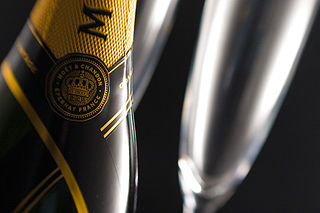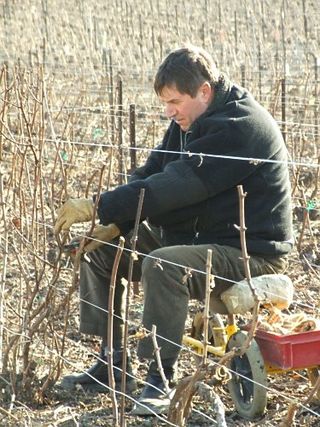Related Research Articles

Champagne is a sparkling wine originated and produced in the Champagne wine region of France under the rules of the appellation, which demand specific vineyard practices, sourcing of grapes exclusively from designated places within it, specific grape-pressing methods and secondary fermentation of the wine in the bottle to cause carbonation.

The wine region within the historical province of Champagne in the northeast of France is best known for the production of champagne, the sparkling white wine that bears the region's name. EU law and the laws of most countries reserve the term "champagne" exclusively for wines that come from this region located about 160 kilometres (100 miles) east of Paris. The viticultural boundaries of Champagne are legally defined and split into five wine-producing districts within the historical province: Aube, Côte des Blancs, Côte de Sézanne, Montagne de Reims, and Vallée de la Marne. The city of Reims and the town of Épernay are the commercial centers of the area. Reims is famous for its cathedral, the venue of the coronation of the French kings and a UNESCO World Heritage Site.

Sparkling wine is a wine with significant levels of carbon dioxide in it, making it fizzy. While it is common to refer to this as champagne, European Union countries legally reserve that word for products exclusively produced in the Champagne region of France. Sparkling wine is usually either white or rosé, but there are examples of red sparkling wines such as the Italian Brachetto, Bonarda and Lambrusco, and the Australian sparkling Shiraz. The sweetness of sparkling wine can range from very dry brut styles to sweeter doux varieties.

Taittinger is a French wine family who are famous producers of Champagne. The estate is currently headed by Vitalie Taittinger, who is the daughter of Pierre-Emmanuel Taittinger, a member of the consultative committee of the Banque de France. Its diversified holdings included Champagne Taittinger, Société du Louvre and Concorde Hotels, whose flagship is the famed Hotel de Crillon on the Place de la Concorde in Paris, France as well as the Loire Valley wine-producing firm of Bouvet-Ladubay, and a partnership in Domaine Carneros in California. All these holdings were sold to Starwood Capital in 2005. The family re-acquired the house of Champagne Taittinger in 2006 after securing financial support from the Crédit Agricole bank and also the backing of trade organisations.

Moët & Chandon, also known simply as Moët, is a French fine winery and part of the luxury goods company LVMH Moët Hennessy Louis Vuitton SE. Moët et Chandon is one of the world's largest champagne producers and a prominent champagne house. Moët et Chandon was established in 1743 by Claude Moët, and today owns 1,190 hectares of vineyards, and annually produces approximately 28,000,000 bottles of champagne.

A winemaker or vintner is a person engaged in winemaking. They are generally employed by wineries or wine companies, where their work includes:

Chambertin is an Appellation d'origine contrôlée (AOC) and Grand Cru vineyard for red wine in the Côte de Nuits subregion of Burgundy, with Pinot noir as the main grape variety. Chambertin is located within the commune of Gevrey-Chambertin, and it is situated approximately in the centre of a group of nine Grand Cru vineyards all having "Chambertin" as part of their name. The other eight vineyards, which all are separate AOCs, have hyphenated names where Chambertin appears with a prefix, such as Chapelle-Chambertin. Chambertin itself is situated above the Route des Grands Crus. It borders on Chambertin-Clos de Bèze in the north, Griotte-Chambertin and Charmes-Chambertin in the east and the Latricières-Chambertin in the south. The AOC was created in 1937.
Dawnine Sample Dyer is an American winemaker and entrepreneur who pioneered the use of champagne-making methods in California's fledgling sparkling wine industry in the 1970s.

California wine production has a rich viticulture history since 1680 when Spanish Jesuit missionaries planted Vitis vinifera vines native to the Mediterranean region in their established missions to produce wine for religious services. In the 1770s, Spanish missionaries continued the practice under the direction of the Father Junípero Serra who planted California's first vineyard at Mission San Juan Capistrano.
Château Miraval is a château and vineyard located in the village of Correns, just north of Brignoles, a village in the Var département in the south of France. The château hit headlines in late May 2008 when it was revealed that Brad Pitt and Angelina Jolie had leased it for three years with an option to buy, after surveying prospective properties by helicopter, with the intention of having the twins they expected born in France. Pitt and Jolie exercised the buy option and were married in the château's chapel in August 2014.

Duval-Leroy is a Champagne producer based in Vertus, a village in the Côte des Blancs region of Champagne. The house, founded in 1859, produces both vintage and non-vintage cuvées as well as a line of organic wines. The house of Duval-Leroy is also known for its pioneering role in promoting a sustainable development model for its viticulture.

The history of Champagne began when the Romans planted vineyards in this region of northeast France in the 5th century, or possibly earlier. Over centuries, Champagne evolved from being a pale, pinkish still wine to a sparkling wine. When Hugh Capet was crowned King of France in 987 at the cathedral of Reims, he started a tradition that brought successive monarchs to the region—with the local wine being on prominent display at the coronation banquets. The early wine of the Champagne region was a pale, pinkish wine made from Pinot noir.

The classification of Champagne vineyards developed in the mid-20th century as a means of setting the price of grapes grown through the villages of the Champagne wine region. Unlike the classification of Bordeaux wine estates or Burgundy Grand cru vineyards, the classification of Champagne is broken down based on what village the vineyards are located in. A percentile system known as the Échelle des Crus acts as a pro-rata system for determining grape prices. Vineyards located in villages with high rates will receive higher prices for their grapes than vineyards located in villages with a lower rating. While the Échelle des Crus system was originally conceived as a 1-100 point scale, in practice, the lowest rated villages are rated at 80%. Premier crus villages are rated between 90 and 99 percent while the highest rated villages, with 100% ratings are Grand crus.

Grower Champagnes or Artisan Champagnes are Champagnes produced by the estate that owns the vineyards where the grapes are grown. Récoltant-Manipulant is the term in French, and Grower Champagnes can be identified by "RM" on the wine label. While large Champagne houses such as Mumm, Moët et Chandon and Veuve Clicquot may use grapes from as many as 80 different vineyards in the Champagne region to create a consistent house style, Grower Champagnes tend to be more terroir-focused, sourced from a single vineyard or closely located vineyards around a village, and made with grapes which vary with each vintage. Today there are over 19,000 independent growers in the Champagne region, accounting for nearly 88% of vineyard land in the region; around 5,000 of these growers produce wine from their own grapes. Of the Champagne imported into the US in 2014, only 5% was Grower Champagne.
Jacques Selosse is a Champagne producer and grower based in the Avize region of Champagne. The house has been rated as one of Champagne’s top five producers by Andrew Jefford in The New France.
Domaine Armand Rousseau is a French wine grower and producer. It is based in Gevrey-Chambertin, in the Côte de Nuits wine-growing region of Burgundy, France.
The Zinfandel Advocates and Producers(ZAP) is a consortium of over 200 winemakers and grape growers, as well as thousands of consumers, with the purpose of advocating, preserving, and educating about the Zinfandel grape. Started in 1991, the organizational structure of combining wine enthusiasts with wine producers served as a successful template for other wine-related organizations, such as the Rhone Rangers. ZAP is reported to be one of the largest consumer-based wine advocacy groups in the world.
Agrapart & Fils is a Grower Champagne producer which makes organic wines with a focus on terroir.
Anthony "Tony" Douglas Jordan was an Australian winemaker and oenologist.
References
- 1 2 "Drinking Time Itself: The Champagnes of Anselme Selosse". Vinography.Com: A Wine Blog. 26 May 2015. Retrieved 2016-09-24.
- ↑ "Champagne Selosse: The House that Jacques Built - World Of Fine Wine". www.worldoffinewine.com. 19 February 2014. Retrieved 2016-09-24.
- 1 2 3 4 McInerney, Jay (2013-12-27). "The Indie Innovator of Champagne Country". Wall Street Journal. ISSN 0099-9660 . Retrieved 2016-09-24.
- ↑ "Champagne's Pop Stars" . Retrieved 2016-09-24.
- ↑ "Selosse Champagne - Rare Wine Co". www.rarewineco.com. Retrieved 2016-09-24.
- ↑ White, David (2016). But First, Champagne. New York, NY, USA: Skyhorse Publishing. p. 251. ISBN 978-1-5107-1144-0.
- ↑ Asimov, Eric (15 June 2006). "Tiny Bubble-Makers" . Retrieved 2016-09-24.
- ↑ SMITH, ROD (2001-12-26). "The Questing Knight of New Age Champagne". Los Angeles Times. ISSN 0458-3035 . Retrieved 2016-09-24.
- ↑ Journal, William Echikson Special to The Wall Street (2002-12-06). "Something New Is Bubbling In the Champagne Region". Wall Street Journal. ISSN 0099-9660 . Retrieved 2016-09-24.
- ↑ "Champagne's solo act: Single-vineyard bottlings allow France's revered houses to buck tradition". 6 June 2008. Retrieved 2016-09-24.
- ↑ "France's Distinctive, Affordable Champagne". Departures. Retrieved 2016-09-24.
- ↑ "Hotel Restaurant les Avises (Avize, France) - UPDATED 2016 Hotel Reviews - TripAdvisor". www.tripadvisor.com. Retrieved 2016-09-24.